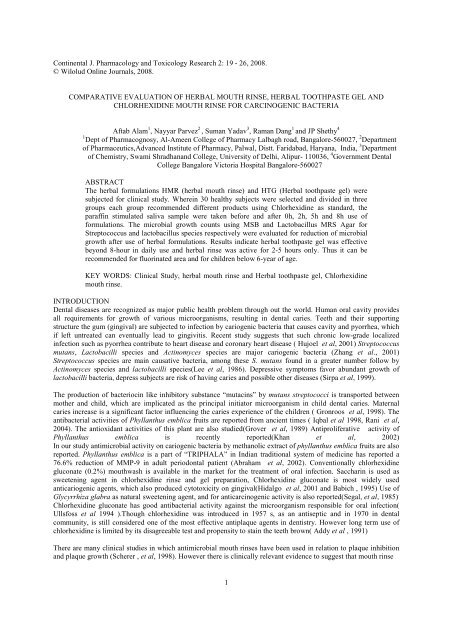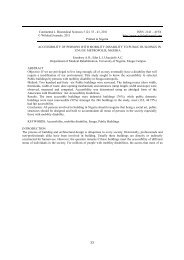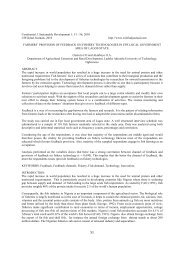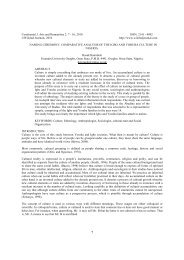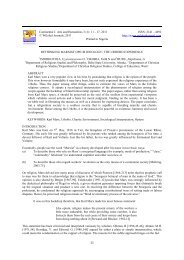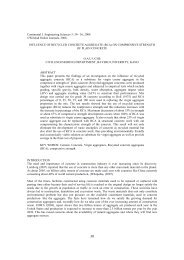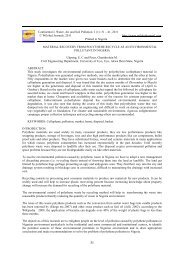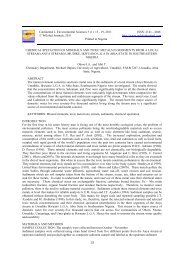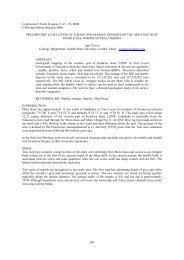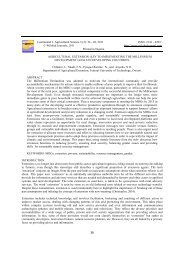1 Continental J. Pharmacology and Toxicology ... - Wilolud Journals
1 Continental J. Pharmacology and Toxicology ... - Wilolud Journals
1 Continental J. Pharmacology and Toxicology ... - Wilolud Journals
Create successful ePaper yourself
Turn your PDF publications into a flip-book with our unique Google optimized e-Paper software.
<strong>Continental</strong> J. <strong>Pharmacology</strong> <strong>and</strong> <strong>Toxicology</strong> Research 2: 19 - 26, 2008.© <strong>Wilolud</strong> Online <strong>Journals</strong>, 2008.COMPARATIVE EVALUATION OF HERBAL MOUTH RINSE, HERBAL TOOTHPASTE GEL ANDCHLORHEXIDINE MOUTH RINSE FOR CARCINOGENIC BACTERIAAftab Alam 1 , Nayyar Parvez 2 , Suman Yadav 3 , Raman Dang 1 <strong>and</strong> JP Shethy 41 Dept of Pharmacognosy, Al-Ameen College of Pharmacy Lalbagh road, Bangalore-560027, 2 Departmentof Pharmaceutics,Advanced Institute of Pharmacy, Palwal, Distt. Faridabad, Haryana, India, 3 Departmentof Chemistry, Swami Shradhan<strong>and</strong> College, University of Delhi, Alipur- 110036, 4 Government DentalCollege Bangalore Victoria Hospital Bangalore-560027ABSTRACTThe herbal formulations HMR (herbal mouth rinse) <strong>and</strong> HTG (Herbal toothpaste gel) weresubjected for clinical study. Wherein 30 healthy subjects were selected <strong>and</strong> divided in threegroups each group recommended different products using Chlorhexidine as st<strong>and</strong>ard, theparaffin stimulated saliva sample were taken before <strong>and</strong> after 0h, 2h, 5h <strong>and</strong> 8h use offormulations. The microbial growth counts using MSB <strong>and</strong> Lactobacillus MRS Agar forStreptococcus <strong>and</strong> lactobacillus species respectively were evaluated for reduction of microbialgrowth after use of herbal formulations. Results indicate herbal toothpaste gel was effectivebeyond 8-hour in daily use <strong>and</strong> herbal rinse was active for 2-5 hours only. Thus it can berecommended for fluorinated area <strong>and</strong> for children below 6-year of age.KEY WORDS: Clinical Study, herbal mouth rinse <strong>and</strong> Herbal toothpaste gel, Chlorhexidinemouth rinse.INTRODUCTIONDental diseases are recognized as major public health problem through out the world. Human oral cavity providesall requirements for growth of various microorganisms, resulting in dental caries. Teeth <strong>and</strong> their supportingstructure the gum (gingival) are subjected to infection by cariogenic bacteria that causes cavity <strong>and</strong> pyorrhea, whichif left untreated can eventually lead to gingivitis. Recent study suggests that such chronic low-grade localizedinfection such as pyorrhea contribute to heart disease <strong>and</strong> coronary heart disease ( Hujoel et al, 2001) Streptococcusmutans, Lactobacilli species <strong>and</strong> Actinomyces species are major cariogenic bacteria (Zhang et al., 2001)Streptococcus species are main causative bacteria, among these S. mutans found in a greater number follow byActinomyces species <strong>and</strong> lactobacilli species(Lee et al, 1986). Depressive symptoms favor abundant growth oflactobacilli bacteria, depress subjects are risk of having caries <strong>and</strong> possible other diseases (Sirpa et al, 1999).The production of bacteriocin like inhibitory substance “mutacins” by mutans streptococci is transported betweenmother <strong>and</strong> child, which are implicated as the principal initiator microorganism in child dental caries. Maternalcaries increase is a significant factor influencing the caries experience of the children ( Gronroos et al, 1998). Theantibacterial activities of Phyllanthus emblica fruits are reported from ancient times ( Iqbal et al 1998, Rani et al,2004). The antioxidant activities of this plant are also studied(Grover et al, 1989) Antiproliferative activity ofPhyllanthus emblica is recently reported(Khan et al, 2002)In our study antimicrobial activity on cariogenic bacteria by methanolic extract of phyllanthus emblica fruits are alsoreported. Phyllanthus emblica is a part of “TRIPHALA” in Indian traditional system of medicine has reported a76.6% reduction of MMP-9 in adult periodontal patient (Abraham et al, 2002). Conventionally chlorhexidinegluconate (0.2%) mouthwash is available in the market for the treatment of oral infection. Saccharin is used assweetening agent in chlorhexidine rinse <strong>and</strong> gel preparation, Chlorhexidine gluconate is most widely usedanticariogenic agents, which also produced cytotoxicity on gingival(Hidalgo et al, 2001 <strong>and</strong> Babich , 1995) Use ofGlycyrrhiza glabra as natural sweetening agent, <strong>and</strong> for anticarcinogenic activity is also reported(Segal, et al, 1985) .Chlorhexidine gluconate has good antibacterial activity against the microorganism responsible for oral infection(Ullsfoss et al 1994 ).Though chlorhexidine was introduced in 1957 s, as an antiseptic <strong>and</strong> in 1970 in dentalcommunity, is still considered one of the most effective antiplaque agents in dentistry. However long term use ofchlorhexidine is limited by its disagreeable test <strong>and</strong> propensity to stain the teeth brown( Addy et al , 1991)There are many clinical studies in which antimicrobial mouth rinses have been used in relation to plaque inhibition<strong>and</strong> plaque growth (Scherer , et al, 1998). However there is clinically relevant evidence to suggest that mouth rinse1
Aftab Alam et al: <strong>Continental</strong> J. <strong>Pharmacology</strong> <strong>and</strong> <strong>Toxicology</strong> Research 2: 19 - 26, 2008.containing active agent are effective against carcinogenic bacteria( Vanka , et al, 2001) Limited information’s areavailable regarding to herbal formulation hence this study is designed <strong>and</strong> carried out with the following aim <strong>and</strong>objective. To compare the efficacy of HMR rinse, HTG <strong>and</strong> chlorhexidine mouth rinse on cariogenic microorganism(Sreptococcus mutans <strong>and</strong> lactobacilli species) for daily use of formulations.MATERIALS AND METHODSPlants materials selection <strong>and</strong> extractionFruits of Phyllanthus emblica Linn <strong>and</strong> roots of Glycyrrhiza glabra Linn were collected from local market inBangalore <strong>and</strong> authenticated by Shri Gajendra Rao, Survey Officer, Regional Research Institute (Ay.). 200 gram ofdrugs were defatted by petroleum ether <strong>and</strong> then subjected to soxhlet extraction for 6-hours with methanol. Thesolvent was removed using rotary evaporator to get a dry residue. These extracts were stored in airtight container at4 0 C.FormulationsMouth rinse (Vanka , et al, 2001 <strong>and</strong> Aftab 2007)HMR contains Phyllanthus emblica extract as active constituent, Glycyrrhiza glabra active as well as sweeteningagent, peppermint oil as flavor, <strong>and</strong> the concentration of Phyllanthus emblica <strong>and</strong> Glycyrrhiza glabra are not lessthan 20mg/ml, pH-7Tooth gel. ( Vanka , et al, 2001,Aftab , 2007 )HTG contains Phyllanthus emblica extract as active constituent, Glycyrrhiza glabra active as well as sweeteningagent, Carbopol as gelling agent, Sorbitol as humectants, calcium carbonate as abrasive, xanthin gum as thickeningagent, peppermint oil as flavor, <strong>and</strong> the concentration of Phyllanthus emblica <strong>and</strong> Glycyrrhiza glabra are not lessthan 20mg/g. pH-7In vitro evaluation of herbal toothpaste gel <strong>and</strong> herbal mouth rinse of Phyllanthus emblica <strong>and</strong> Glycyrrhizaglabra extracts almost equivalent to commercial formulations (Noveon, 1911)Clinical evaluationsTo compare the efficacy of HT-gel <strong>and</strong> Herbal mouth rinse with chlorhexidine mouth rinse on cariogenicmicroorganism (Sreptococcus mutans <strong>and</strong> lactobacilli species) for duration of inhibition activity during 12 h.Subject Selection: 30 male subjects of 18-25 years age were selected from Al-Ameen College of PharmacyBangalore, Karnataka, India. After taking consent, the selected subjects were medically healthy with no systemicdisease, free from diabetics <strong>and</strong> did not have use any antibiotic or antiseptic mouthwash during the last two weeks.Smokers were not included in this group (Aftab et al, 2008)ProcedureGrouping of subjects (Almas ,et al, 2004)All Subjects were divided into 3- groups with 10 subjects in each groupGroup 1 – HMR: Ten subjects were asked to rinse their mouth with 15ml of “HMR” for 5 min. A 2ml of stimulatedsaliva was collected before <strong>and</strong> after 0-h, 2h, 5h, <strong>and</strong> 8-h, rinsing with HM Rinse.Group 2 – Chlorhexidine gluconate (0.2%): Ten subjects were asked to rinse with 15ml of Chlorhexidine gluconate(0.2%) for 5 min. A 2ml of stimulated saliva was collected before <strong>and</strong> after 0-h, 2h, 4h, 8-h, <strong>and</strong> 12-h rinsing withChlorhexidine.Group 3 –HTG: Ten subjects were asked to apply 1g of HT-gel thoroughly in oral cavity for 6 min. A 2ml ofstimulated saliva was collected before <strong>and</strong> after 0-h, 2h, 4h, 8-h, <strong>and</strong> 12-h application of HT-gel.Collection of salivaMidmorning stimulated salivary sample were collected from the subjects, followed by a small piece of paraffin wax(1cm Long) <strong>and</strong> asked to chew for a period of 30 second swallowing only saliva but not the paraffin. There after thesubjects were asked to continue chewing the wax <strong>and</strong> the saliva was collected at two-minute interval for total periodof 6 minutes. 2ml of saliva was collected in to a sterile glass cup. This process is repeated for 2h, 4h, <strong>and</strong> 8h. Thedietary factor was not included in this study.2
Aftab Alam et al: <strong>Continental</strong> J. <strong>Pharmacology</strong> <strong>and</strong> <strong>Toxicology</strong> Research 2: 19 - 26, 2008.Antimicrobial activityUsing an automatic micropipette with sterile plastic tips 1.5ml of saliva was transferred into the ependroff tubes <strong>and</strong>agitated for 30 sec on vortex mixture. The salivary samples were diluted in 0.05M Phosphate buffer (pH-7.0) to thedilution of 10 -2 - 10 -3 ( Larmas , 1992 <strong>and</strong> Adamkova ,et al, 2004). For the cultivation of mutant streptococcusmutans <strong>and</strong> lactobacilli species, 50 µL of the dilution was incubated on MSB agar media <strong>and</strong> Lactobacillus MRSAgar media (Kohler B,et al, 1979 <strong>and</strong> Westergren ,et al, 1978 ). The agar Plate was incubated anaerobically inanaerobic jar (5%Co 2 <strong>and</strong> 95% N 2 ) at 37 o C for 48 h.. Mutant streptococci <strong>and</strong> lactobacilli colonies are identified onthe agar plate by its typical colonial morphology. The number of mutans streptococci <strong>and</strong> lactobacilli colonyforming unit (CFU) per mal of saliva were estimated <strong>and</strong> scored as below (Kulkarni VV, et al, 2003 <strong>and</strong> Pai MR, etal 2004)ScoreScore-1Score-2Score-3Score-4Streptococcus mutans< 104 CFU/ml104- 105 CFU/ml105-106 CFU/ml> 106 CFU/mlLactobacilli species105 CFU/mlStatistical analyses were carried out compare the percentage difference inhibition of carcinogenic bacteria <strong>and</strong>average bacterial growth before <strong>and</strong> after use of formulations. The percentage difference of salivary bacteria wasgiven in Table -1 (S. mutans) <strong>and</strong> Table-2 (Lactobacilli sp.) growth <strong>and</strong> graph show the average bacterial growthbefore <strong>and</strong> after 0h, 2h, 5h, <strong>and</strong> 8h were shown in graph 1 (S. mutans) <strong>and</strong> graph 2 (lactobacilli species).RESULTSClinical studyIn present study comparative clinical study of herbal formulation <strong>and</strong> marketed formulation were carried inGovernment dental college. The study was designed to analysis the effectiveness of formulation in 8-hour use. Forthe study 30 subjects were divided in three groups i.e. Herbal rinse groups were 10 subjects, Chlorhexidine groupswere 10 subjects <strong>and</strong> Herbal tooth gel groups were 10 subjects. Each subject was previously given demonstrationbefore collecting the saliva 2ml paraffin stimulated saliva was collected before <strong>and</strong> after 0 hour, 2 hours, 5 hours <strong>and</strong>8 hours use of formulation. The antimicrobial activity was evaluated using MSB agar for S. mutans <strong>and</strong>Lactobacillus MRS Agar for Lactobacillus species <strong>and</strong> the bacterial colony was counted using colony counter after48-hour incubation in 10% CO 2 incubator. The percentage difference of Streptococcus mutans after 0h, 2h, 5h <strong>and</strong>8h are reported in Table No 1 <strong>and</strong> percentage difference of Lactobacilli species after use of 0h, 2h, 5h <strong>and</strong> 8h arereported in Table No 2. The graph shows the average microbial growth in saliva before <strong>and</strong> after use offormulations. Figure No 1, indicate the average S. mutans in saliva before <strong>and</strong> after 0h, 2h, 5h <strong>and</strong> 8h <strong>and</strong> Figure No.2, indicate the average lactobacillus species before <strong>and</strong> after 0h, 2h, 5h <strong>and</strong> 8h use of formulations.DISCUSSIONIn present study the main aim was to prepare an effective formulation for human use, <strong>and</strong> maintain proper oralhygiene upto 8 hours. The selected formulations were comparatively evaluating in-vivo in a study carried out atGovernment Dental College Bangalore. The midmorning paraffin stimulated saliva was taken before <strong>and</strong> afterimmediate (0h), 2h, 5h <strong>and</strong> 8h use of formulation. The microbial count of each salivary extract of herbal rinse groupsindicated after use, 90% inhibition of SM <strong>and</strong> lactobacilli species <strong>and</strong> after 5h, 10% reduction of SM <strong>and</strong>lactobacilli species indicate herbal mouth rinse (HM rinse) was effective for 5 hour only. The microbial count ofeach salivary extract of CH x rinse groups indicated after use 100% reduction of SM <strong>and</strong> lactobacilli species <strong>and</strong>after 8h, 20% reduction of SM <strong>and</strong> 0.00% reduction of Lactobacilli species, concluded that CHx mouth rinse waseffective for 5 to 8 hours. Herbal toothpaste gel (HT-gel) groups were indicate after application 100% reduction ofSM <strong>and</strong> lactobacilli species <strong>and</strong> after 8h, 70 % reduction of SM <strong>and</strong> 60% reduction of Lactobacilli species,concluded that HT-gel was effective for greater than 8 hours. In present study herbal formulation do not contain anyfluoride ingredient so it can be used in fluorosis condition <strong>and</strong> area where water fluoride level is high <strong>and</strong> alsorecommended for children below 6 years.3
Aftab Alam et al: <strong>Continental</strong> J. <strong>Pharmacology</strong> <strong>and</strong> <strong>Toxicology</strong> Research 2: 19 - 26, 2008.CONCLUSIONThe clinical study of formulation indicates HT-gel (1gram) was active for 12-hours in maintaining oral hygienecondition while CH X (Std-10ml) was active for 5-8 hours <strong>and</strong> Herbal mouth rinse (10ml) was active for 2-5 hour.ACKNOWLEDGEMENTS.We would like to thank Prof. B.G Shivan<strong>and</strong>a, Principal Al-Ammen College of Pharmacy, Dr. Salma KhanamHOD, Dept. of Pharmacognosy Al-Ammen College of Pharmacy Bangalore Karnataka India, for providing suchgood environment for this projects. Dr. Jaye Prasad N Shethy Principal Gov. Dental College Bangalore KarnatakaIndia, provided us with additional data for his dual-buffering system <strong>and</strong> also provide facilities for achievement oftarget.Table –1: Percentage differences of S. mutans after 0h, 2h, 5h <strong>and</strong> 8h use of formulationsGroup Timeintervals4(n%)3(n%)HMR 0 hour - 1(10%)2(n%)5(50%)1(n%)3(30%)0(n%)1(10%)Total(n%)10(100%)2hour - - 2(20%)6(60%)2(20%)10(100%)5hour - - - 1(10%)9(90%)8 hour - - - - 10(100%)CH x Rinse 0 hour - 45 10(40%) (50%) (10%) (0.00%)10(100%)10(100%)10(100%)2 hour - 1(10%)5(10%)3(30%)1(10%)10(100%)5 hour - - 3(30%)4(40%)8 hour - - - 2(20%)3(30%)8(80%)10(100%)10(100%)HTG 0 hour 2(20%)5(50%)3(30%)0(0.00%)0(0.00%)10(100%)2 hour - 4(40%)5(50%)1(10%)0(0.00%)10(100%)5 hour - - 5(50%)8 hour - - 1(10%)4(40%)6(60%)1(10%)3(30%)10(100%)10(100%)CH x = Chlorhexidine gluconate (0.2%), HMR= Herbal mouth rinse, HTG= Herbal toothpaste gel.4
Aftab Alam et al: <strong>Continental</strong> J. <strong>Pharmacology</strong> <strong>and</strong> <strong>Toxicology</strong> Research 2: 19 - 26, 2008.Table –2: Percentage differences of lactobacillus species after 0h, 2h, 5h <strong>and</strong> 8h use of selected formulation.GroupHMRTimeintervals4(n%)3(n%)2(n%)0 hour - - 2(20%)1(n%)7(70%)0(n%)1(10%)Total(n%)10(100%)2hour - - - 8(80%)5hour - - - 1(10%)2(20%)9(90%)10(100%)10(100%)CH x Rinse8 hour - - - - 10(100%)0 hour - - 5(50%)5(50%)0(0.00%)10(100%)10(100%)2 hour - - 4(40%)5(50%)1(10%)10(100%)5 hour - - - 5(50%)5(50%)10(100%)HTG8 hour - - - - 10(100%)0 hour - 2(20%)5(50%)3(30%)0(0.00%)10(100%)10(100%)2 hour - - 6(60%)4(40%)0(0.00%)10(100%)5 hour - - 2(20%)7(80%)1(10%)10(100%)8 hour - - - 6(60%)4(40%)10(100%)CH x = Chlorhexidine gluconate (0.2%), HMR= Herbal mouth rinse, HTG= Herbal toothpaste gel5
Aftab Alam et al: <strong>Continental</strong> J. <strong>Pharmacology</strong> <strong>and</strong> <strong>Toxicology</strong> Research 2: 19 - 26, 2008.Figure 1: Average reduction of Streptococcus mutans before <strong>and</strong> after 0h, 2h, 5h <strong>and</strong> 8h use of formulations.Reduction of Streptococcus mutansAverage S. mutans insaliva43.532.521.510.50HMR CHx MR HTPGBefore use0h2h5h8hFormulationsFigure 2: Average reduction of Lactobacillus species before <strong>and</strong> after 0h, 2h, 5h <strong>and</strong> 8h use of formulations.ciliab ato livc ala seg .inpraesvA2.521.510.50Reduction of Lactobacillus speciesHMR CHx MR HTPGFormulationsBeforeuse0hREFERENCESAbraham S, Kumar MS, Sehgal PK, Nitish S, Jayakumar ND. Evaluation of the inhibitory effect of triphala onPMN-type matrix metalloproteinase (MMP-9). J Periodontol 2005;76(4):497-502.Adamkova H, Vicar J, Palasova J, Ulrichova J, Simanek V. Macleya cordata <strong>and</strong> Prunella vulgaris in oral hygieneproducts - their efficacy in the control of gingivitis. Biomed Pap Med Fac Univ Palacky Olomouc Czech Repub2004;148(1):103-105.Addy M, al-Arrayed F, Moran J. The use of an oxidizing mouthwash to reduce staining associated withchlorhexidine. Studies in vitro <strong>and</strong> in vivo. J Clin Periodontol 1991;18(4):267-271.Aftab Alam, Raman Dang: Evaluation of Herbal Toothpaste gel <strong>and</strong> Herbal Mouth rinse with commercialformulation-an in vitro study. J Biomed 2008;2(1):194-199Aftab Alam, Raman Dang: In-vitro anticariogenic activity of five selected medicinal plants against Streptococcusmutans, Lactobacillus lactis <strong>and</strong> Actinomyces. J. Biomed 2007:59-62.6
Aftab Alam et al: <strong>Continental</strong> J. <strong>Pharmacology</strong> <strong>and</strong> <strong>Toxicology</strong> Research 2: 19 - 26, 2008.Almas K, Al-Zeid Z. The immediate antimicrobial effect of a toothbrush <strong>and</strong> miswak on cariogenic bacteria: aclinical study. J Contemp Dent Pract 2004;5(1):105-114.Babich H, Wurzburger BJ, Rubin YL, Sinensky MC, Blau L. An in vitro study on the cytotoxicity of chlorhexidinedigluconate to human gingival cells. Cell Biol Toxicol 1995;11(2):79-88.Gronroos L, Saarela M, Matto J, Tanner-Salo U, Vuorela A, Alaluusua S. Mutacin production by Streptococcusmutans may promote transmission of bacteria from mother to child Infect 1998;66(6):2595-2600.Grover IS, Kaur S. Effect of Emblica officinalis Gaertn. (Indian gooseberry) fruit extract on sodium azide <strong>and</strong> 4-nitro-o-phenylenediamine induced mutagenesis in Salmonella typhimurium. Indian J Exp Biol 1989;27(3):207-209.Hidalgo E, Dominguez C. Mechanisms underlying chlorhexidine-induced cytotoxicity. Toxicol in Vitro 2001;15(4-5):271-276.Hujoel PP, Drangsholt M, Spiekerman C, DeRouen TA. Periodontal disease <strong>and</strong> coronary heart disease risk. JAMA2001;285(1):40-45.Iqbal A, Zafar M, Faiz M. Screening of some Indian medicinal plants for their antimicrobial properties. JournalEthnopharmacol 1998; 62(2):183-193.Khan MT, Lampronti I, Martello D, Bianchi N, Jabbar S, Choudhuri MS, Datta BK, Gambari R. Identification ofpyrogallol as an antiproliferative compound present in extracts from the medicinal plant Emblica officinalis: effectson in vitro cell growth of human tumor cell lines. Int J Oncol 2002;21(1):187-192.Kohler B, Bratthall D. Practical method to facilitate estimation of Streptococcus mutans levels in saliva. J ClinMicrobiol 1979;9(5):584-588.Kulkarni VV, Damle SG. Comparative evaluation of efficacy of sodium fluoride, chlorhexidine <strong>and</strong> triclosan mouthrinses in reducing the Mutans streptococci count in saliva: an in vivo study. J Indian Soc Pedod Prev Dent2003;21(3):98-104.Larmas M. Saliva <strong>and</strong> dental caries: diagnostic tests for normal dental practice. Int Dent J 1992;42(4):199-208.Leach PA, Bullen JJ, Grant ID. Anaerobic CO 2 cabinet for the cultivation of strict anerobes. Appl Microbiol1971;22(5):824-827.Lee RB, Ronald JB, Allan GK. Quantitative comparison of potentially cariogenic microorganisms cultured fromnon-carious <strong>and</strong> carious root <strong>and</strong> coronal tooth surface. Infect <strong>and</strong> Immunit 1986;51(3):765-770.Noveon 19 Bulletin. Formulation of toothpaste using carbopol. The specialty chemical innovator TM . Head quarterUSA, Inc 1911 Brecksville road Clevel<strong>and</strong>, Ohio 44141-3242. WWW.pharma.noveoninc.Pai MR, Acharya LD, Udupa N. Evaluation of antiplaque activity of Azadirachta indica leaf extract gel--a 6-weekclinical study. J Ethnopharmacol 2004;90(1):99-103.Rani P, Khullar N. Antimicrobial evaluation of some medicinal plants for their anti-enteric potential against multidrugresistant Salmonella typhi. Phytother Res 2004;18(8):670-673.Scherer W, Gultz J, Lee SS, Kaim J. The ability of an herbal mouthrinse to reduce gingival bleeding. J Clin Dent1998;9(4):97-100.Segal R, Pisanty S, Wormser R, Azaz E, Sela MN. Anticariogenic activity of licorice <strong>and</strong> glycyrrhizine I: Inhibitionof in vitro plaque formation by Streptococcus mutans. J Pharm Sci 1985;74(1):79-81.7
Aftab Alam et al: <strong>Continental</strong> J. <strong>Pharmacology</strong> <strong>and</strong> <strong>Toxicology</strong> Research 2: 19 - 26, 2008.Sirpa SA, Matti LE, Tero KS. Depressive symptoms favour abundant growth of salivary lactobacilli. Psychosomaticmedicine 1999;61:508-512.Ullsfoss BN, Ogaard B, Arends J, Ruben J, Rolla G, Afseth J. Effect of a combined chlorhexidine <strong>and</strong> NaFmouthrinse: an in vivo human caries model study. Sc<strong>and</strong> J Dent Res 1994;102(2):109-112.Vanka A, T<strong>and</strong>on S, Rao SR, Udupa N, Ramkumar P. The effect of indigenous Neem Azadirachta indica [correctionof (Adirachta indica)] mouthwash on Streptococcus mutans <strong>and</strong> lactobacilli growth. Indian J Dent Res2001;12(4):193.Westergren G, Krasse B. Evaluation of a micromethod for determination of Streptococcus mutans <strong>and</strong> Lactobacillusinfection. J Clin Microbiol 1978;7(1):82-83Wilkinson JB, Moore RJ: Harry's Cosmeticology. New York, NY Chemical Publishing 1982:608-629.Zhang T, Zhang Y, Zhang C, Yang S. Pathogen of root surface caries in the elderly. Chin Med J (Engl)2001;114(7):767-778.Received for Publication: 21/08/2008Accepted for Publication: 28/08/2008Corresponding AuthorSuman YadavDepartment of Chemistry, Swami Shradhan<strong>and</strong> College, University of Delhi, Alipur- 110036, India.8


